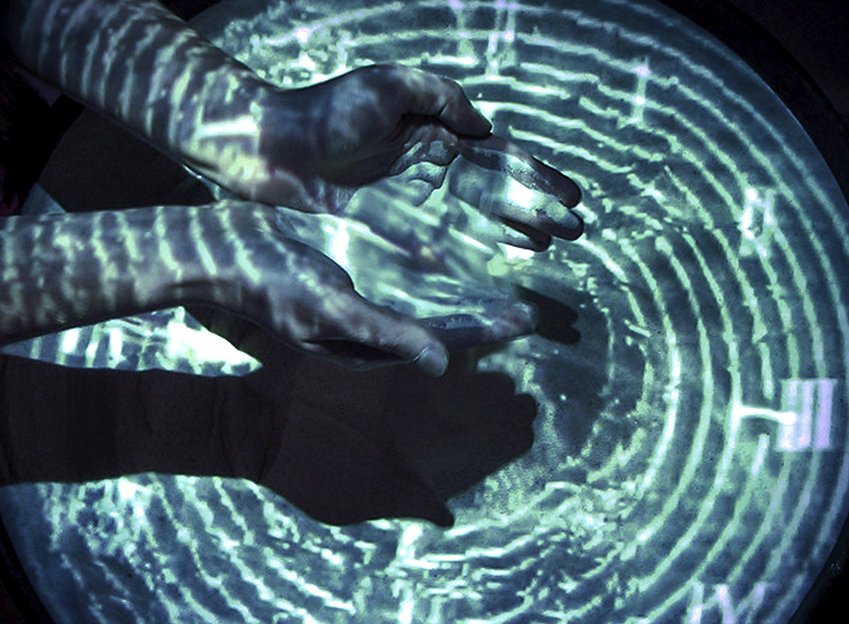
SAND-CLOCK
Ficha técnica: Arena de desierto, sensores de movimiento, video mono canal, componentes sonoros, aromas, sobre base de madera cilíndrica. Medidas variables.
SAND-CLOCK es una instalación inmersiva e interactiva de video y sonido que invita al público a reflexionar sobre el tiempo y el espacio como una experiencia fluida e indivisible. Un reloj proyectado sobre la arena transcurre con normalidad hasta que el espectador interviene, activando distorsiones visuales mediante el movimiento de sus manos.
En el núcleo de la obra, un minotauro con un hacha doble recorre un laberinto circular, símbolo del tiempo cíclico y del espacio interior. Al acercarse y acariciar la arena, el espectador provoca efectos visuales similares a ondas líquidas, como las que se forman al tocar la superficie de un lago. Ríos llama a estas alteraciones ecos de tiempo: resonancias sensibles que emergen del contacto entre el cuerpo y la imagen.
La obra incorpora el sonido de doce relojes mecánicos —cada uno representando un intervalo de dos horas para completar las 24 horas del día— junto con sensores de movimiento, arena digital y un entorno sonoro envolvente. En conjunto, estos elementos transforman el tiempo en una experiencia táctil y expandida.
Cada uno de los doce relojes simboliza dos horas del día, creando un entorno inmersivo que disuelve la percepción lineal del tiempo y lo reinterpreta como una dimensión sensible.
SAND-CLOCK no solo desafía a los espectadores a repensar el tiempo, sino que también los invita a explorar su relación con el espacio a través de un lenguaje artístico que conecta lo tangible con lo intangible, lo físico con lo conceptual. Esta pieza, que combina técnicas audiovisuales y sonoras, ofrece un espacio de introspección, meditación y participación activa, convirtiendo al espectador en un agente esencial de la obra.
________________________________________________
SAND-CLOCK fue galardonada con el Premio Siemens-RMIT de Bellas Artes 2010 y recibió una Beca de estudios doctorales en artes visuales en la Royal Melbourne Institute of Technology (RMIT), Melbourne, Australia.
________________________________________________
SAND-CLOCK (English)
Technical specifications: Natural desert sand, motion sensors, single-channel video, sound components, aromas, mounted on a cylindrical wooden base. Variable dimensions.
SAND-CLOCK is an immersive and interactive installation of video and sound that invites the audience to reflect on time and space as a fluid and indivisible experience. A projected clock over the sand flows naturally until the viewer intervenes, activating visual distortions through the movement of their hands.
At the core of the work, a minotaur with a double axe wanders through a circular labyrinth, symbolizing cyclical time and inner space. By approaching and touching the sand, the viewer triggers visual effects resembling liquid ripples, akin to those formed when touching the surface of a lake. Ríos refers to these alterations as echoes of time: sensitive resonances emerging from the connection between the body and the image.
The piece incorporates the sound of twelve mechanical clocks—each representing a two-hour interval to complete the 24 hours of the day—alongside motion sensors, digital sand, and an immersive soundscape. Together, these elements transform time into a tactile and expansive experience.
Each of the twelve clocks symbolizes two hours of the day, creating an immersive environment that dissolves the linear perception of time and reinterprets it as a sensory dimension.
SAND-CLOCK not only challenges viewers to rethink time but also invites them to explore their relationship with space through an artistic language that bridges the tangible and the intangible, the physical and the conceptual. This piece, which combines audiovisual and sonic techniques, offers a space for introspection, meditation, and active participation, turning the viewer into an essential agent within the work.
________________________________________________
SAND-CLOCK was awarded the 2010 Siemens-RMIT Fine Art Prize and received a doctorate PhD scholarship in Visual Arts at the Royal Melbourne Institute of Technology (RMIT), Melbourne, Australia.
